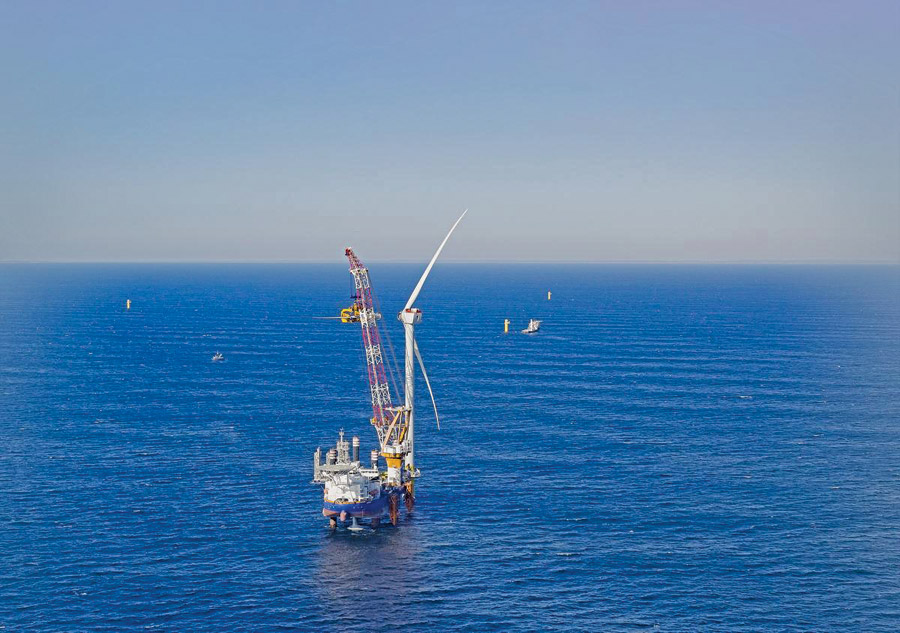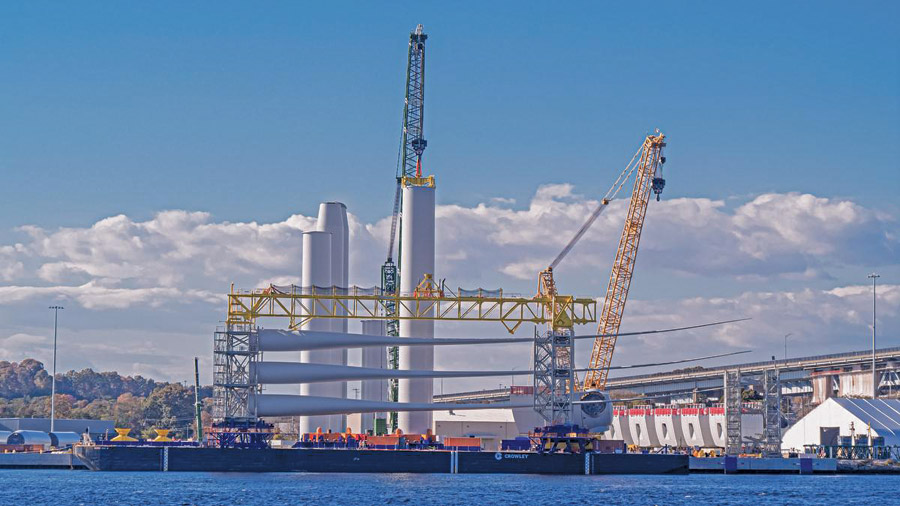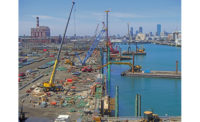South Fork wind
East Hampton, N.Y.
BEST PROJECT, ENERGY/INDUSTRIAL
KEY PLAYERS
Submitted by: Eversource Energy
Developers: Eversource Energy; Ørsted
Lead Design Firms (Onshore): HDR and TRC Cos.
General Contractor (Onshore) | Duct Bank and Substation Installation: Haugland Group
Construction Manager (Onshore): Burns & McDonnell
EPC Contractor (Offshore Substation): Kiewit Offshore Services
Cable Installation (Onshore): LS Cable/Hawkeye
Cable Installation (Offshore): DEME
Landfall Horizontal Directional Drilling: Michels
Turbine Secondary Steel: Riggs Distler
Turbine Installation: Siemens Gamesa Renewable Energy
Turbine Foundations: Boskalis
As the first utility-scale offshore wind energy project to operate in New York—and in the U.S.—South Fork Wind marks a major milestone in the transition to renewable power. Located off the Long Island coast in federal waters, the 130-MW project is designed to meet growing area energy demands by producing clean power for about 70,000 homes.
The project, which started construction in January 2022 and was commissioned in December 2023, was led by Ørsted Offshore North America, which developed the offshore infrastructure, and utility Eversource Energy, which led the onshore effort.
“Customers were saying that they want power to be clean, and this was the way within our geography to make that happen,” says Julia Bovey, spokesperson for Eversource. “For New England and the Northeast, offshore wind is our [opportunity], and we need to figure out how to use it.”

Project structures and materials were stored and assembled at the New London State Pier in Connecticut.
Photo courtesy South Fork Wind
The wind farm features 12 Siemens Gamesa wind turbines, each generating 11 MW, which were installed roughly 35 miles offshore of East Hampton, N.Y. The turbines feed into a 500-ton, 60-ft-tall offshore substation that was designed and fabricated by Kiewit Offshore Services at its facility in Ingleside, Texas, near Corpus Christi.
More than 350 workers in three states supported construction of the structure. The substation was transported by barge across the Gulf of Mexico and up the East Coast for installation at the South Fork Wind project site. “The production of clean energy is at a pivotal stage in the U.S., and offshore wind, such as the South Fork Wind project, plays a very important role,” says Paul Geldmeier, who leads Kiewit’s offshore wind power work as executive vice president of its energy unit.
The project delivers power through a single 138-kV transmission line connected to the East Hampton substation. A 68-nautical mile submarine cable extends from the wind project site to its landfall below Wainscott Beach in East Hampton.

Crews perform turbine blade installation at sea.
Photo courtesy South Fork Wind
Onshore Effort
The onshore scope of the project proved to be a critical phase for South Fork Wind to meet the target of delivering energy to the grid by 2023. A 40-acre terminal at the New London, Conn., port area had a $250-million renovation as the project marshalling and assembly site. It also is set to serve Orsted’s 920-MW Sunrise Wind and 704-MW Revolution Wind projects.
Transparent and frequent communication across multiple teams and stakeholders proved critical for the project, says the award submission. Weekly communication with residents and local leaders through media outlets and social media helped address concerns and maintain community support. Weekday onshore construction was restricted to a 7 a.m. to 7 p.m. window with limited weekend work. In some high traffic areas, such as roads and beaches, no work was conducted during the May through September seasonal period.
The team ensured that all homes along the route and the local beach access point were accessible to homeowners and beachgoers. Traffic could only be temporarily paused to allow for safe working conditions. As additional protection, temporary sound walls were installed as needed. Meeting local, state, and federal permit requirements was another critical part of the project. The submission cites teamwork and continuous communication with regulators as needed to navigate the complex permitting landscape effectively, remain compliant and avoid delays.
One of the most complex aspects of the project was sea-to-shore transition, where horizontal directional drilling was necessary to connect the offshore and onshore transmission systems. Crews installed cable approximately 80 ft beneath the beach to protect infrastructure from erosion and storm impacts. The technical complexities and environmental considerations of drilling required meticulous planning.

The project team loaded giant turbine blades at the New London assembly site.
Photo courtesy South Fork Wind
Meeting Point
A transition joint bay was where the project scopes of Ørsted and Eversource connected. “At the transition interface point, we had to coordinate our designs, cable testing and all of the different phases of construction that encompass landfall,” says Vinny Montemurro, project manager at Burns McDonnell, which served as a program manager on South Fork starting in 2018 with an added construction management role in 2020.
Construction took about 16 months from breaking ground to repaving roads. Building onshore transmission included a 4.1-mile cable route to a new onshore substation. Trenching was used to install underground cable infrastructure along the onshore route. During trenching, areas up to 600 ft in length were opened, then filled and patched once the infrastructure was set. The cable was pulled through the duct bank system at each vault location.
Onshore work was done with union labor, with an emphasis also to use local and M/WBE firms, says the team. “The completion and full integration of South Fork Wind positions New York as a national leader in climate initiatives,” Gary LaBarbera, president of New York State Building Trades, said in a statement. The project had no recordable incidents or lost-time accidents in 233,081 worker hours. Eversource says knowledge and experience gained from South Fork Wind have been shared “across the industry, driving innovation and paving the way for future projects.”
Gov. Kathy Hochul (D) said the project represents progress toward the state goal to develop 9 GW of offshore wind energy by 2035. “This milestone underscores the tremendous opportunity we have to create a new industry from the ground up to drive our green energy economy,” she said in a statement.
[Editor’s note: Eversource Energy in October completed the sale of its 50% interest in South Fork Wind and Revolution Wind to Global Infrastructure Partners. The latter project is set to serve Rhode Island and Connecticut by 2026. Eversource remains a tax equity investor in South Fork Wind and is a contractor on Revolution Wind for onshore construction.]




